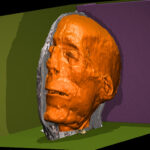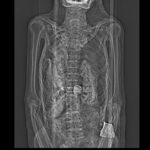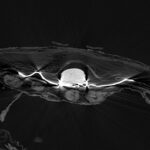 The ancient Egyptian mummy of the priest Khonsu-maa-kheru from Thebes (right) dates from the time of Pharaoh Osorkon I and is approximately 2900 years old. In 1903, it was donated to the Museum of Ethnology in Hamburg, today’s Museum at the Rothenbaum – Cultures and Arts of the World (MARKK).
The ancient Egyptian mummy of the priest Khonsu-maa-kheru from Thebes (right) dates from the time of Pharaoh Osorkon I and is approximately 2900 years old. In 1903, it was donated to the Museum of Ethnology in Hamburg, today’s Museum at the Rothenbaum – Cultures and Arts of the World (MARKK).
Fortunately, the mummy was not unwrapped, as it was often the case at that time. Instead, it became one of the first mummies ever to be examined with X-rays, which had been discovered only a few years earlier. Already then, a winged scarab was discovered on the chest of the deceased.

 In 1996, cross-sectional images of the entire mummy were created using computed tomography (CT). A scout view (left) illustrates the approximate position and size of the scarab. On a CT scan (right), it is clearly visible as a bright, i.e. very dense object between linen bandages and thorax.
In 1996, cross-sectional images of the entire mummy were created using computed tomography (CT). A scout view (left) illustrates the approximate position and size of the scarab. On a CT scan (right), it is clearly visible as a bright, i.e. very dense object between linen bandages and thorax.
The views of the winged scarab shown here were reconstructed from a stack of CT images. The body is made of stone (possibly lapis lazuli), the setting and the wings are made of thin sheet metal. At the top and sides of the body, details such as the wing covers (elytra) and stylized legs (one to the front, two to the back) are clearly visible. As we have no information about the natural colors, the colors used for these renderings were selected according to artistic aspects.
The winged scarab still rests inside the mummy of Khonsu-maa-kheru, as it has for 2900 years.
References
- Renate Germer, Karl Heinz Höhne, Christoph Koch: Neue Einblicke in eine Mumie – die Röntgenuntersuchung der Mumie des Chonsu-maa-cheru [New insights into a mummy – the X-ray examination of the mummy of Khonsu-maa-kheru]. In Wulf Köpke, Bernd Schmelz (eds.): Alt-Ägypten, Mitteilungen aus dem Museum für Völkerkunde Hamburg, Neue Folge Band 30, Holos Verlag, Bonn, 2001, 172-181.
See also head and body of other Egyptian mummies
Back to the Virtual Mummy


